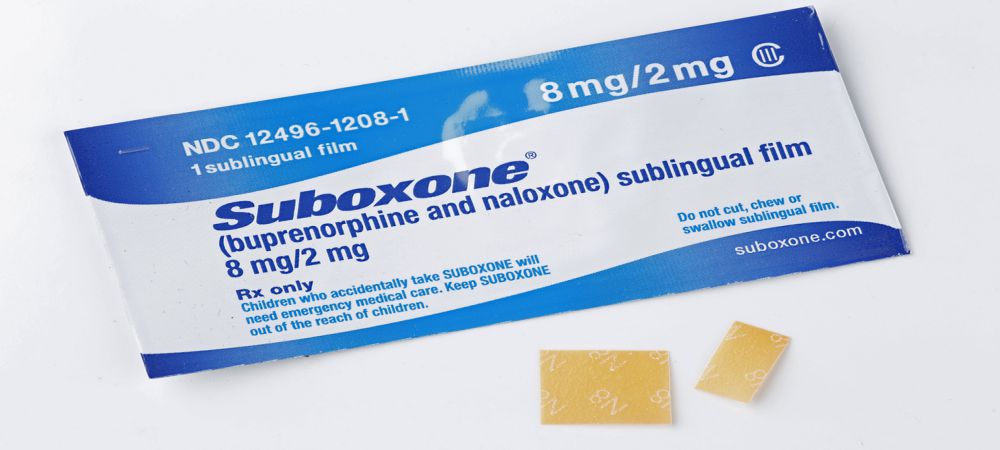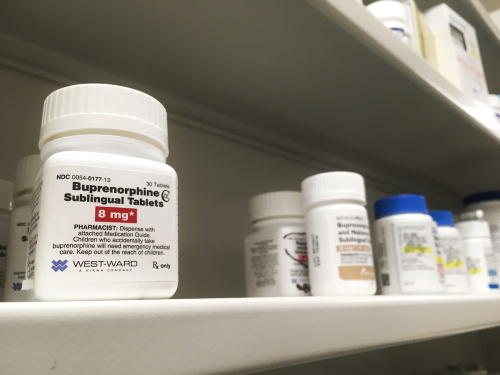
Suboxone is a synthetic drug used to help treat people who are addicted to opioids like heroin or fentanyl. Suboxone is intended to help ease withdrawal opioid symptoms while discouraging abuse [1]. This effect is created by Suboxone’s 4:1 ratio of buprenorphine (Subutex), a mild opioid, and Naloxone (Narcan), which reverses the effects of opioids if injected.
What’s in Suboxone:
Buprenorphine: A partial opioid agonist that activates the same opioid receptors as drugs like heroin but to a lesser degree [3]. For an analogy think of the knobs on a sink. Turn them a little and some water trickles out (buprenorphine). Turn them more and a lot of water rushes out (heroin).
Naloxone: An opioid antagonist or blocker [3]. Paramedics in several states carry high doses of naloxone to treat opioid overdose victims. When injected, Naloxone can instantly undo the effects of opioids including reversing opioid overdoses.
Doctors do not prescribe suboxone for pain. Because the buprenorphine in suboxone is a partial opioid agonist it is not as strong as other pain management medications. People in pain will do anything they can to stop being in pain, including taking high amounts of suboxone if they thought it would help. Unfortunately, the liver metabolizes suboxone very slowly which would make the overdose risk very high.
Yes. Because Suboxone contains an opioid, it can be addictive if taken for too long. Ordinarily, suboxone is used in detox, the first step of recovery, to help wean people off hard drugs like heroin or fentanyl by lessening their withdrawal symptoms. This usually lasts 1-2 weeks, and if suboxone is taken for longer than that the human body will become dependent on it just like it was to hard drugs like heroin.
Put simply, any opioid, no matter how strong, is habit-forming if taken for long enough. As one detox physician told Steven Scanlan M.D, “do not stay on this drug [Suboxone] for more than three weeks, or else you’ll be dealing with a whole different problem” [5].

According to the DSM (Diagnostic Statistics Manual), an addiction to suboxone or other opioids can be diagnosed if two of the following are true in the past 12 months [6]:
Since opioids work by slowing the body, when they are withdrawn the body experiences an overcorrection and become hyperactive. These symptoms include [7]:
Myth: You can’t get high off Suboxone.
Truth: Suboxone is an opioid. If you take enough you will feel high. It is even possible to get the “nodding” effect of opioids from Suboxone. If you take Suboxone orally, the naloxone does nothing to prevent opioid highs.
Myth: Suboxone has naloxone in it which means you can take suboxone and not be affected by other opioids and you cant overdose on opioids.
Truth: Suboxone does have Naloxone which is an opioid antagonist. However Naloxone has no effect unless it’s injected, and suboxone is dissolved under the tongue or cheek. As a result, when taken orally the naloxone in suboxone has no ability to block opioids or prevent overdoses. This is because naloxone cannot pass through the cellular membranes in your mouth and never reaches the blood or brain [1] [2].
Myth: Taking suboxone can cause opioid withdrawals.
Truth: The only way suboxone can cause opioid withdrawals is if it’s injected. This lets the naloxone start removing opioids from your system.
Myth: Injecting Suboxone creates instant opioid withdrawals because Suboxone has naloxone.
Truth: You have to inject a lot of suboxone to create a serious opioid withdrawal. Injecting any suboxone will start a mild withdrawal as the naloxone begins working. However, unless a lot is injected the effect of Naloxone will be minimal. This is because buprenorphine binds more easily and tightly to opioid receptors than Naloxone [1] [2].
According to several reviews [9] [10], the physical pain of Suboxone withdrawal peaks between 7 and 11 on the Clinical Opiate Withdrawal Scale (COWS). On this scale, 5-12 indicates mild pain, 13-24 is moderate, 25-36 is moderately-severe, and anything higher than 36 is severe. So while withdrawal symptoms may last longer than they would when quitting drugs, they will likely be less painful.
Another common use of suboxone is in part of what’s called the “harm reduction” model of addiction treatment. Essentially the thinking goes that most drug users want to quit, and tries to keep drug users (and the community) safe from their addiction until that day comes.
As a result of harm reduction, governments created clean needle exchange programs to prevent the spread of blood borne diseases and opened clinics for suboxone or methadone. Both of which are weaker and harder to overdose on compared to heroin or fentanyl. The downside of harm reduction when it comes to suboxone is that often people who replace heroin with suboxone become addicted to it, and end up needing a longer detox.
Several studies place the average length of physical detox symptoms from suboxone at one month [8]. However, people who are older, weigh more, take higher doses, or have compromised liver function may take longer to detox.
Physical detox symptoms last while the liver removes all drug-related toxins from the blood and body. Suboxone has a half-life of 24-36 hours (the amount of time it takes for the body to process and excrete 50% of the drug) but it is normally taken once every 24 hours [5]. This causes the drug to build-up in the blood. From there it easily dissolves in or merges with fat, the excess Suboxone ends up in the body’s fat stores [5]. Because the liver must now remove the drug from the blood and from however many fat cells were affected, this prolongs the period of physical detox [5].
Alcohol affects neurotransmitters in the brain, much like many other addictive substances. Neurotransmitters are chemicals that send messages to the neurons in your brain. This process controls your behavior, movement, speech, and thought. GABA, a neurotransmitter, is produced when you drink. GABA helps control perceptions of fear and anxiety. This influx of GABA suppresses glutamate (which governs learning and memory). Drinking also leads to increased production of dopamine, the chemical in the brain responsible for pleasure and reward. Too much alcohol use increases the production of GABA, glutamate, and dopamine, making the brain slow its natural production of the chemicals. The body begins to need more alcohol to supplement the low level of natural chemicals. This, in turn, leads to an increased tolerance. This cycle continues until drinking is needed to complete even simple daily tasks.
Every day, hundreds of people become addicted to medicine that was intended to help them. Suboxone is no exception. If you or someone you love wants to get off suboxone call us anytime at 855-202-2138.
Tree House Recovery is a new kind of rehab with a unique blend of treatments. Every patient receives months of intense care designed to rebuild them. Socially, biologically, and psychologically. The result is a stronger, more confident, kinder, well-adjusted man, with a network of support.
For more info: See reviews from former patients, our success rates, read about our staff, or look at our facilities.
Disclaimer:
No content on this website should ever be used as a substitution for direct medical care and advice from qualified physician clinician.
Talk to a Treatment Advisor Today